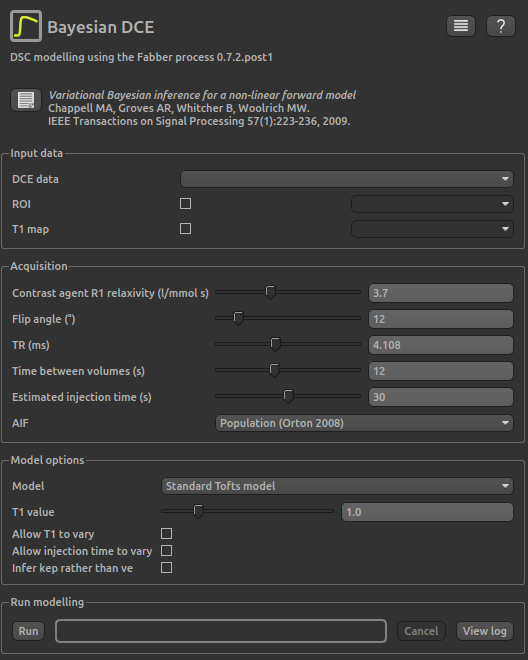DCE modelling widget user interface¶

Input data¶
DCE datais used to select the data set containing the 4D DCE time seriesROIis used to select an optional region of interest data setT1is used to select an optional T1 map (e.g. derived from VFA images using the T1 widget). If a T1 map is not provided a single T1 value must be specified. This can be allowed to vary on a voxelwise basis as part of the fitting process.
Acquisition¶
Contrast agent relaxivityshould be the T1 relaxivity from the manufaturer’s documentation. A list of commonly used agents and their relaxivities is also given at List of relaxivities.Flip angleis defined by the acquisition parameters and should be given in degrees.- Similarly
TRis the repetition time for the acquisition and should be given in milliseconds.Time between volumesshould be given in seconds. In some cases this may not be fixed as part of the acquisition protocol, but instead a series of volumes acquired, each with the time at which it was acquired. In this case you must determine a sensible time difference to use, for example by dividing the total acquisition time by the number of volumes acquired.Estimated injection timeis the time delay between the first acquisition and the introduction of the DCE contrast agent in seconds. The latter is often not given immediately in order to establish a baseline signal. The delay time can be estimated as part of the modelling process - this is recommended to account for not just injection delay but also the variable transit time of the contrast agent to different voxels.
Model options¶
- A selection of models are available - see Models available for Bayesian DCE modelling for a full description.
- Similarly the choice of AIF is described in AIF options for Bayesian DCE modelling.
- A T1 value in seconds must be given if a T1 map is not provided in the input data section.
- If
Allow T1 to varyis selected the T1 value (whether from a T1 map or the value given in this section) is allowed to vary slightly on a voxelwise basis. In general if you do not have a T1 map it is recommended to allow the T1 to vary to reflect variation within the region being modelled. If you do have a T1 map you may choose to treat this as ground truth and not allow it to vary in the modelling.- If
Allow injection time to varyis selected, then the delay time from the start of the acquisition to the arrival of the DCE tracer is inferred as part of the model fitting. Usually this should be enabled as described above, to account for variable transit times to different voxels.- For the Tofts model, there is a choice to infer \(K_{ep}\) rather than \(V_e\). These are equivalent parameters related by the equation \(V_e = K_{trans} / K_{ep}\). Sometimes one choice may be more numerically stable than the other.